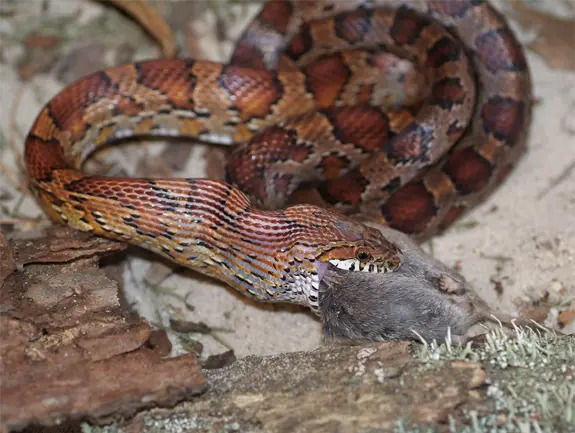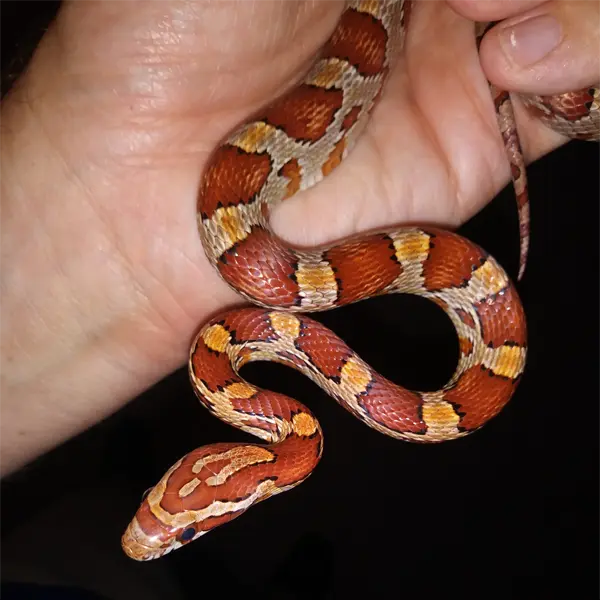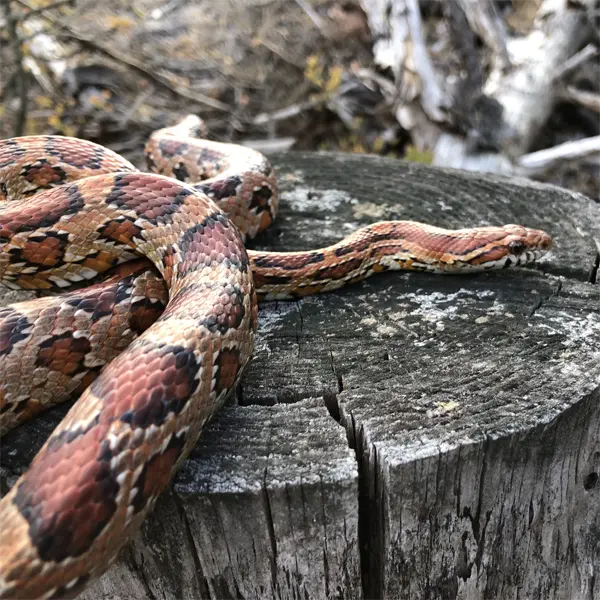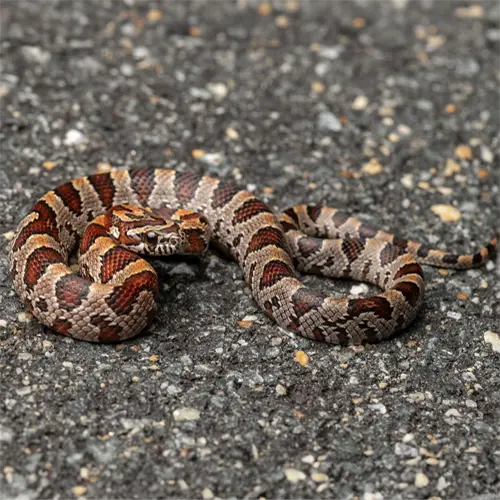Corn Snakes in Central Florida
The corn snake (Pantherophis guttatus) is a docile, attractive serpent that thrives in the warm environments of central Florida. This colubrid species is appreciated by reptile enthusiasts for its calm temperament and attractive patterns. Corn snakes are also one of the most popular pet snakes kept in captivity.
This guide provides identification tips, biology facts, ideal habitat conditions, common health risks, and prevention methods for corn snakes in central Florida.
Appearance and Identification
Corn snakes can be identified by their slender build, keeled scales, and distinctive patterning
Corn snakes can be differentiated from the superficially similar scarlet kingsnake by their lack of nose pigment and the order of their ventral scales. Proper identification aids safe relocation if encountered.
Maturation Rate
Corn snakes hatch from eggs measuring around 2-3 inches (5-7 cm) long. After their first shed cycle, hatchlings become more active feeders. They grow quickly, able to take adult mice within their first year, reaching 2-3 feet (60-90 cm) long.
Maturation slows after sexual maturity. Adult size is achieved by 2-3 years old. With abundant food, corn snakes can attain maximum lengths of 5-6 feet (150-180 cm) though average adult size is smaller. Proper nutrition and habitat aids healthy development.
Habits and Behavior
Corn snakes are primarily crepuscular and nocturnal, becoming more active at dawn, dusk, and night when temperatures are favorable. During hot mid-day hours, they retreat to hides and burrows.
These terrestrial snakes inhabit wooded areas, overgrown fields, barns, and abandoned buildings. Excellent climbers, corn snakes ascend trees and rafters with ease. They are also adept swimmers and burrowers able to exploit a variety of habitats.
Though non-venomous, corn snakes may vibrates their tails and strike defensively if threatened. Otherwise, they tend to be slow-moving and docile unless handled roughly. Corn snakes are solitary except when breeding or during brumation.
Reproduction and Lifespan
Corn snakes reach breeding maturity at 18-36 months old. Breeding occurs soon after spring emergence. Females emit pheromones to attract males who engage in ritualistic courtship combat dances.
Eggs are laid in abandoned rodent burrows, rotting logs, compost piles, and other humid sheltered sites. Clutches contain 4-24 eggs which hatch after 60-70 days incubation. Hatchlings grow rapidly feeding on mice, lizards, and other small prey.
In captivity, corn snakes live 15-20 years on average with proper husbandry. Lifespans over 23 years have been reported. Their longevity reflects their flexible survival adaptations.
Ideal Habitat and Range
The warm, humid environment of central Florida provides prime corn snake habitat. Average temperatures range from the 60s°F (15-20°C) in north Florida to the 70s°F (21-26°C) in southern regions. Summer highs reach the 90s°F (32-35°C). Rainfall exceeds 50 inches (1270 mm) annually.
Corn snakes inhabit overgrown fields, barns, forests, and wetlands throughout central Florida’s rural areas. Rodent prey is abundant. Urban corn snakes shelter in abandoned lots, sheds, and woodpiles. Their ability to thrive across diverse terrain makes corn snakes ubiquitous.
As cold-blooded reptiles, corn snakes regulate their body temperature through external heat sources. Access to sun-heated retreats allows them to remain active during cooler months. Central Florida’s mild winters prevent prolonged brumation, supporting year-round corn snake activity.
Diet and Feeding
Corn snakes are carnivorous, feeding primarily on small mammals and occasionally birds, amphibians, lizards, and eggs. Hatchlings start on pinky mice, graduating to adult mice, and eventually small rats. An adult corn snake eats 1-2 adult mice per week.
Their sharp, backward-curving teeth allow corn snakes to seize prey and swallow it whole. Heat-sensing pits help target warm-blooded prey. Strong jaws facilitate eating large meals equaling up to 25% of their own body weight.
In central Florida, corn snakes forage for rodents around barns and abandoned buildings. Well-fed captive snakes readily accept thawed frozen rodents. Ample prey availability supports corn snake populations across central Florida.

Photo 112373853 © bobzappalorti, CC BY-NC

Common Health Risks
Though non-venomous, corn snakes can bite defensively if threatened. Their rear-facing teeth can lacerate skin and cause infection if not properly cleaned. Serious injury is rare and often due to improper handling.
Salmonella is present in reptile intestinal tracts and can be transmitted through improper sanitation. Always wash hands after handling snakes or enclosures. Keep corn snake habitats clean to minimize disease risks.
Overall, captive corn snakes pose few health hazards with responsible ownership. Wild snakes should not be captured or handled. Give corn snakes space if encountered outdoors. With proper hygiene and care, corn snakes make safe, rewarding pets.
Preventing Corn Snake Encounters
The best means of avoiding corn snakes around homes is reducing habitat appeal. Keep vegetation trimmed back from foundations. Seal crawl space and basement entries. Remove woodpiles and debris that offer shelter. Ensure windows and doors fit tightly.
Scent deterrents like sprinkling lime or ammonia around foundations may discourage snake access. Moth balls and sulfur-containing granules can also repel snakes when applied around properties. Avoid using chemical pesticides.
Glue boards, tubular plastic guards, and mesh screen can be installed to block snakes. Seek professional removal if snakes access indoor spaces. Maintaining exclusion and reducing habitat suitability provides long-term prevention.
Corn Snakes in Central Florida – Conclusion
The corn snake is well established across central Florida thanks to the region’s warm, humid climate and abundant prey. They inhabit rural buildings and overgrown lots, sometimes ranging close to homes. With proper exclusion and habitat modification, encounters can be minimized.
Captured snakes should be safely relocated away from residences by trained handlers. Though startling if seen, corn snakes are generally harmless and help control rodent populations. With informed management, corn snakes and homeowners can coexist in central Florida’s shared spaces.







